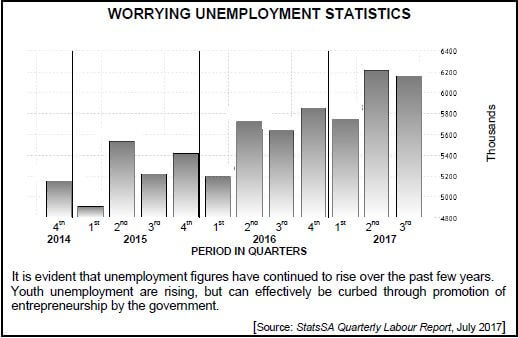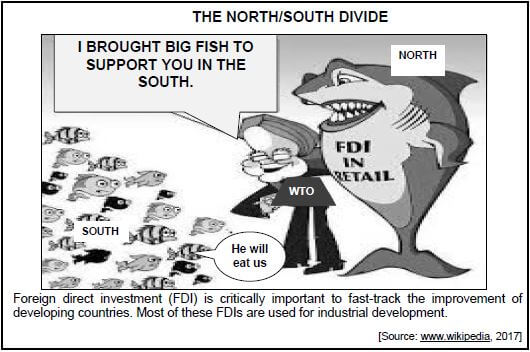ECONOMICS PAPER 1 GRADE 12 QUESTIONS - AMENDED SENIOR CERTIFICATE EXAMS PAST PAPERS AND MEMOS MAY/JUNE 2018
Share via Whatsapp Join our WhatsApp Group Join our Telegram GroupECONOMICS
PAPER 1
GRADE 12
AMENDED SCE PAST PAPERS AND MEMOS
MAY/JUNE 2018
INSTRUCTIONS AND INFORMATION
- Answer FOUR questions as follows in the ANSWER BOOK:
SECTION A: COMPULSORY
SECTION B: Answer TWO of the three questions.
SECTION C: Answer ONE of the two questions. - Answer only the required number of questions. Answers in excess of the required number will NOT be marked.
- Number the answers correctly according to the numbering system used in this question paper.
- Write the question number above each answer.
- Read the questions carefully.
- Start EACH question on a NEW page.
- Leave 2–3 lines between subsections of questions.
- Answer the questions in full sentences and ensure that the format, content and context of your responses comply with the cognitive requirements of the questions.
- Use only black or blue ink.
- You may use a non-programmable pocket calculator.
- Write neatly and legibly.
QUESTIONS
SECTION A (COMPULSORY)
QUESTION 1 30 MARKS – 20 MINUTES
1.1 Various options are provided as possible answers to the following questions. Choose the answer and write only the letter (A–D) next to the question numbers (1.1.1 to 1.1.8) in the ANSWER BOOK, for example 1.1.9 D.
1.1.1 The practice of selling goods in a foreign country at lower prices than in the country of origin is known as …
- exportation.
- dumping.
- importation.
- import substitution.
1.1.2 Savings flow back into the circular flow as …
- investments.
- government spending.
- exports.
- imports.
1.1.3 The new economic paradigm that relates to the smoothing of business cycles is rooted in … policies.
- public relations
- trade
- international
- demand-and-supply side
1.1.4 When import duties are imposed as a percentage of the value of the imported goods, it is known as … duties.
- composite
- specific
- ad valorem
- average
1.1.5 An increase in the productive capacity of the economy over a specific period of time is called …
- economic development.
- spatial development.
- economic growth.
- developmental economics.
1.1.6 The interaction of economies with trade as an important element is known as …
- privatisation.
- globalisation.
- entrepreneurship.
- export promotion.
1.1.7 The number of employed persons as a percentage of the economically active population (EAP) is called the …
- employment rate.
- economic growth.
- productivity rate.
- labour productivity.
1.1.8 Economic activities which create value-added products in all sectors is known as … development.
- social
- employment
- mining
- industrial (8 x 2) (16)
1.2 Choose a description from COLUMN B that matches the item in COLUMN A. Write only the letter (A–I) next to the question numbers (1.2.1 to 1.2.8) in the ANSWER BOOK.
COLUMN A | COLUMN B |
1.2.1 Monetary policy |
|
1.3 Give the ONE term for each of the following descriptions. Write only the term next to the question numbers (1.3.1 to 1.3.6) in the ANSWER BOOK. Abbreviations, acronyms and examples will NOT be accepted.
1.3.1 A market for short-term savings and loans
1.3.2 A negative economic growth rate for at least two consecutive quarters
1.3.3 A trade policy that discourages imports to guard domestic industries from harmful foreign competition
1.3.4 The Act that promotes redress and transformation in the workplace in terms of race, gender and disabilities
1.3.5 A policy that targets taxes and government expenditure to influence economic activity
1.3.6 The migration of people from rural areas to cities and towns (6 x 1) (6)
TOTAL SECTION A: 30
SECTION B
Answer any TWO of the three questions in this section in the ANSWER BOOK.
QUESTION 2: MACROECONOMICS 40 MARKS – 30 MINUTES
2.1 Answer the following questions.
2.1.1 Name any TWO member countries of the BRICS trade protocol. (2 x 1) (2)
2.1.2 How can indirect subsidies benefit the export producer? (1 x 2) (2)
2.2 Study the diagram below and answer the questions that follow. 
2.2.1 Identify the trend line in the business cycle above. (1)
2.2.2 Which letter represents a trough in the diagram above? (1)
2.2.3 Briefly describe the term business cycle. (2)
2.2.4 Explain economic activity during phase EF in the business cycle. (2)
2.2.5 How can the length (BF) be used in forecasting of business cycles? (2 x 2) (4)
2.3 Study the table below and answer the questions that follow.
NATIONAL INCOME AND PRODUCTION ACCOUNTS OF SOUTH AFRICA (GVA at constant 2010 prices) | |
GROSS VALUE ADDED BY KIND OF ECONOMIC ACTIVITY | 2016 (Rm) |
Primary Sector | 298 849 |
Secondary Sector | 550 195 |
Tertiary Sector | 1 945 557 |
Gross value added at basic prices | 2 794 601 |
Taxation on products | 30 600 |
Subsidies on products | 5 900 |
Gross Domestic Product at market prices | A |
[Adapted from SARB Quarterly Bulletin, March 2017]
2.3.1 Identify the base year used by the SARB above. (1)
2.3.2 Which sector above contributed most towards the gross domestic product of South Africa? (1)
2.3.3 Briefly describe the term gross value added (GVA) at constant prices. (2)
2.3.4 How would the GDP at market prices be converted to GNP at market prices? (2)
2.3.5 Calculate the gross domestic product at market prices (A). (Show ALL calculations.) (4)
2.4 Briefly explain the measures to reduce a deficit on the balance of payments. (4 x 2) (8)
2.5 Why should South Africa follow a policy of free trade? (8) [40]
QUESTION 3: ECONOMIC PURSUITS 40 MARKS – 30 MINUTES
3.1 Answer the following questions.
3.1.1 Name any TWO social indicators. (2 x 1) (2)
3.1.2 What can the government do during a period of recession to stimulate the economy? (1 x 2) (2)
3.2 Study the extract below and answer the questions that follow.
MANUFACTURING IN SOUTH AFRICA South Africa has developed as an established, diversified manufacturing base with potential to compete in the global economy. This platform of manufacturing presents an opportunity to significantly accelerate the country's growth and development. [Source: Brand South Africa, June 2017] |
3.2.1 Name ONE vehicle manufacturer above, which have production plants in South Africa. (1)
3.2.2 Identify ONE advantage of vehicle production plants located in South Africa in the extract above. (1)
3.2.3 Briefly describe the term free trade area. (2)
3.2.4 What is the purpose of the Southern African Development Community? (2)
3.2.5 How could the government address poverty in South Africa through the manufacturing sector? (2 x 2) (4)
3.3 Study the information below and answer the questions that follow. 
3.3.1 When, according to the graph above, was unemployment at its highest level? (1)
3.3.2 Which institution compiled the unemployment figures above? (1)
3.3.3 Briefly describe the term unemployment. (2)
3.3.4 What is the negative impact of high unemployment on the youth? (2)
3.3.5 How can the government reduce unemployment in the economy? (2 x 2) (4)
3.4 Briefly discuss demographics as social indicator. (4 x 2) (8)
3.5 How can the monetary policy be used to stimulate the economy of South Africa? (8) [40]
QUESTION 4: MACROECONOMICS AND ECONOMIC PURSUITS
40 MARKS – 30 MINUTES
4.1 Answer the following questions.
4.1.1 Give any TWO examples of indirect tax. (2 x 1) (2)
4.1.2 What important role do small, micro and medium enterprises (SMMEs) play in the economy? (1 x 2) (2)
4.2 Study the extract below and answer the questions that follow.
BALANCE OF PAYMENTS: CURRENT ACCOUNT IMPROVES South Africa's current account deficit narrowed in the fourth quarter last year. It is the first time it reached the level of 1,7% of the GDP in nearly six years. [Adapted from News24, August 2017] |
4.2.1 According to the extract above, what was the deficit in the balance of payments in 2016? (1)
4.2.2 In the extract above, identify the term that calculates the difference between goods imported and goods exported. (1)
4.2.3 Briefly describe the term balance of payments. (2)
4.2.4 What is the significance of the balance on the current account? (2)
4.2.5 How can a surplus on the balance of payments affect the South African economy positively? (2 x 2) (4)
4.3 Study the information below and answer the questions that follow. 
4.3.1 Which part of the North/South divide is reflected by the small fishes in the cartoon above? (1)
4.3.2 According to the information above, why is foreign direct investment (FDI) so important for development in countries? (1)
4.3.3 What is the message in the cartoon? (2)
4.3.4 How does mass production by developed countries affect the environment negatively? (2)
4.3.5 How are developing countries disadvantaged by a lack of foreign direct investment? (2 x 2) (4)
4.4 Differentiate between endogenous and exogenous approaches to business cycles. (2 x 4) (8)
4.5 How effective is productivity as an economic indicator? (8) [40]
TOTAL SECTION B: 80
SECTION C
Answer any ONE of the two questions in this section in the ANSWER BOOK. Your answer will be assessed as follows:
STRUCTURE OF ESSAY | MARK ALLOCATION |
Introduction
| Max. 2 |
Body | Max. 26 Max. 10 |
Conclusion
| Max. 2 |
TOTAL | 40 |
QUESTION 5: MACROECONOMICS 40 MARKS – 40 MINUTES
- Discuss the macro-economic objectives of the state. (26 marks)
- How successful has the South African government been in reaching its macro economic objectives? (10 marks) [40]
QUESTION 6: ECONOMIC PURSUITS 40 MARKS – 40 MINUTES
- Discuss in detail the following as South Africa's initiatives in regional development:
- Special Economic Zones (8 marks)
- Corridors (8 marks)
- Spatial Development Initiatives (10 marks)
- How effective is South Africa's regional development policies in terms of international benchmarking? (10 marks) [40]
TOTAL SECTION C: 40
GRAND TOTAL: 150